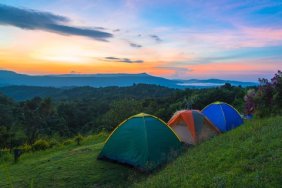 While many associate camping with the summer, when the kids are out of school and the weather is sunny and warm, there are also those who consider it to be a year-round activity and will brave deep snow and frigid temperatures to enjoy it. Camping in the winter requires a few more precautions and practices, however, as the colder temperatures can be unforgiving if you’re unprepared. Today, I’ve outlined a few tips that will help make any winter camping trip less stressful and, more importantly, less cold.
While many associate camping with the summer, when the kids are out of school and the weather is sunny and warm, there are also those who consider it to be a year-round activity and will brave deep snow and frigid temperatures to enjoy it. Camping in the winter requires a few more precautions and practices, however, as the colder temperatures can be unforgiving if you’re unprepared. Today, I’ve outlined a few tips that will help make any winter camping trip less stressful and, more importantly, less cold.
Planning for a winter camping trip starts before you take one step out of your house. For instance, if your destination requires a bit of a drive, and road conditions aren’t the best, due to the snow, then it’s a good idea to leave earlier. This gives you ample time to reach your site and make camp, should you be caught in a snow storm or bad traffic along the way.
As far as clothing is concerned, one important thing to remember is that any cotton clothes should be left at home. Instead, start off with an insulating layer that conforms to your body, such as long underwear from brands like Patagonia, Smartwool, or REI. Your next layer should consist of non-cotton material, like wool or synthetics, which will keep you very warm. Finally, I’d wear a jacket that is both wind and waterproof, as both features will maintain body heat by keeping out cold winds. The benefit with so many layers is that you can remove them, one layer at a time, should you start to get hot. Lastly, be sure to bring extra socks and keep them dry and warm each night by keeping them in your sleeping bag when you sleep.
Shelter is perhaps the most important factor of camping during the winter, as temperatures drop significantly at night, even during mild winters, which can be dangerous if you’re not fully protected. If the weather isn’t too harsh, and temperatures and winds are on the milder side, then a 3-season tent will do fine. However, full-on winters will require a tent specifically designed to protect its users from the freezing climates, as the ventilation and thinner material of a 3-season tent may not be enough. Be sure to pitch your tent in an area that is sheltered from the wind and, if needed, use a tarp to block wind gusts.
Try to pack down the snow upon which you’ll pitch the tent, as well, since sleeping in loose snow will create a mold of your body that will freeze overnight and make sleeping uncomfortable. At night, be sure to put as many barriers as you can between you and the ground by using a sleeping pad beneath your sleeping bag, if possible. Resist the urge to keep your head contained within the sleeping bag as well, as moisture from breathing inside it all night will dampen its interior and reduce its insulation.
Hiking and camping during the winter can be extremely cold and uncomfortable at times, but if you take the time to prepare and properly gear up beforehand, it won’t be nearly as bad as you think. After all, sometimes the difference between a miserable trip and a fun one is one more layer of clothing.








